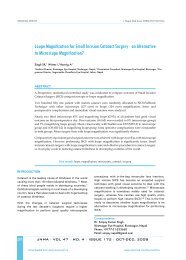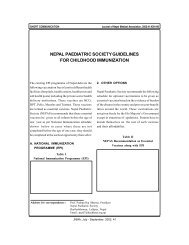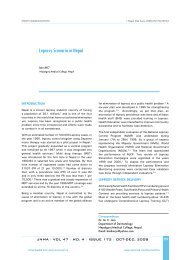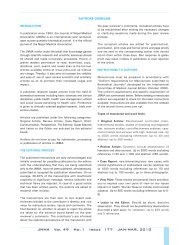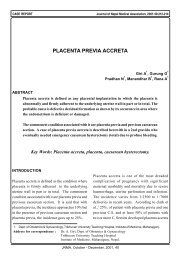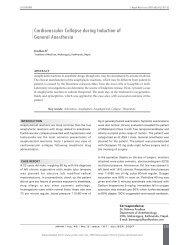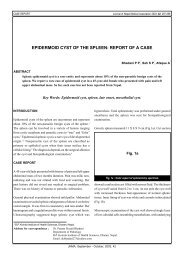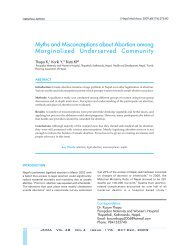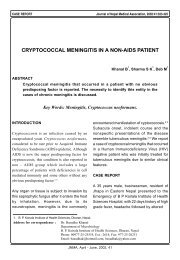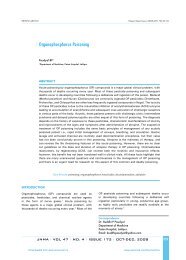JNMA (142) Final - Journal of Nepal Medical Association
JNMA (142) Final - Journal of Nepal Medical Association
JNMA (142) Final - Journal of Nepal Medical Association
- No tags were found...
Create successful ePaper yourself
Turn your PDF publications into a flip-book with our unique Google optimized e-Paper software.
ORIGINAL ARTICLE <strong>Journal</strong> <strong>of</strong> <strong>Nepal</strong> <strong>Medical</strong> <strong>Association</strong>, 2002:41:306-310EFFECT OF CHEMOTHERAPY ON PHILADELPHIA CHROMOSOMEIN CHRONIC MYELOID LEUKEMIA (CML) PATIENTSJha C B 1 , Kucheria K 2 , Chaudhary V P 2ABSTRACTChronic myeloid leukemia (CML) is a clonal myeloproliferative disorder as a result<strong>of</strong> neoplastic transformation <strong>of</strong> the primitive hemopoetic cells. It is well known thatthe Philadelphia chormosome (ph) is a specific abnormality found in 90% <strong>of</strong> CMLpatients. It has been reported that interferon has better effect on disease control andprognosis. Cytogenetic analysis <strong>of</strong> ph chromosome plays very important role in theprognosis and monitoring <strong>of</strong> therapy. In this present study 35 diagnosed patients <strong>of</strong>CML were considered, which included untreated patients <strong>of</strong> various age groups (2-62yrs). The cases were refered from haematology clinic <strong>of</strong> All India Institute <strong>of</strong> <strong>Medical</strong>Sciences (AIIMS). Out <strong>of</strong> 35 patients only 13 patients were available after six month<strong>of</strong> therapy for follow-up cytogenetic analysis. Out <strong>of</strong> 13 patient, 2 were ph negative, 8were 100% ph positive and 3 were ph positive mosaic before therapy. Of the 3 mosaicpatients, 2 remained unchanged after therapy and one patient became 100% phnegative. Though in general significant reduction in ph% by interferon therapy wasseen but minority patients showed complete cytogenetic remission.Key Words: Chronic myeloid leukemia, chemotherapy, Philadelphia chromosome.INTRODUCTIONChronic myeloid leukemia is a clonalmyeloproliferative disorder as a result <strong>of</strong> neoplastictransformation <strong>of</strong> the primitive haemopoietic stemcell. It accounts for about 7-15% <strong>of</strong> all leukemias. 1Males are more commonly affected than female (14:1). 2The Philadelphia (ph) chromosome in themalignant cells is found in more than 90% <strong>of</strong>patients with CML. Nowell and Hungerford 3reported a very small chromosome that appearedto be a partially deleted copy <strong>of</strong> one <strong>of</strong> the twosmallest autosome pairs. This small elementbecame known as the Philadelphia chromosome. 41. B. P. Koirala Institute <strong>of</strong> Health Sciences, Dharan, <strong>Nepal</strong>.2. All India Institute <strong>of</strong> <strong>Medical</strong> Sciences.Address for correspondence : Dr. Chandra Bhushan JhaAssistant Pr<strong>of</strong>essorB.P.K.I.H.S., Dharan, <strong>Nepal</strong>.Email: chandraj_2000@yahoo.com<strong>JNMA</strong>, April - June, 2002, 41
307 Jha et. al. : Effect <strong>of</strong> Chemotherapy on Philadelphia Chromosome ...The genetics <strong>of</strong> CML plays very important role inthe prognosis <strong>of</strong> patient's condition and for themonitoring <strong>of</strong> therapy, which are consistentlyassociated with chromosome abnormality.Cytogenetic molecular analysis <strong>of</strong> the Philadelphiachromosome provide important information to thephysician that are relevant to the leukemic burden<strong>of</strong> the patients.It was planned to study chromosome in clinicallydiagnosed CML patients before and onchemotherapy.MATERIAL AND METHODSThirty- five diagnosed cases <strong>of</strong> chronic myeloidleukemia were considered for this study, whichincluded untreated patients <strong>of</strong> various age groups(2-62years). The diagnosis <strong>of</strong> CML was made onthe basis <strong>of</strong> hematologic investigations, and caseswere refered from hematology clinic <strong>of</strong> AIIMS.SAMPLE COLLECTIONBone marrow (BM) aspiration was done by thehaematologist from the posterior superior iliacspine using heparinised syringe. 1ml <strong>of</strong> aspiratewas collected in a sterile tube containing 5 ml <strong>of</strong>RPMI 1640 (Gibco, BRL) culture mediasupplemented with 10-units/ ml <strong>of</strong> heparin.Samples were transported at room temperature.BONE MARROW CULTUREThe bone marrow aspirate was centrifuged (1000r.p.m; l0 minutes) and washed with RPMI 1640 mediain the same tube in which it was transported. Afterdiscarding the supernatant, the pallet wassupplemented in 5ml <strong>of</strong> RPMI 1640 reconstituted with20% fetal bovine serum (Gibco, BRL). Two vials wereset up for direct harvesting and for short-term culturefor 24 hours in Co 2incubator at 37° centigrade.CHROMOSOME PREPARATIONHarvesting for bone marrow was done usingcolcemid (Gibco, BRL) treatment for 1 hour at aconcentration <strong>of</strong> 0.2/ ml. The culture was centrifugedand the cell pallet was suspended in 10ml <strong>of</strong>hypotonic solution (0.075m pottassium chloride(KCL) for 30 minutes at 37° c. The suspension wasagain centrifuged and the cells were then fixed inmethanol acetic acid fixative 3:1 for over night at-20°c. Precleaned slides were used for chromosomepreparations. The cell suspension was dropped froman approximate distance <strong>of</strong> 40-50 cm on the slideplaced at 30°. Conventional staining was done in4% Giemsa (Gibco, BRL) solution.GTG- BANDINGOn slide stored for 2-4 days at room temperature,GTG- banding was done using modified method <strong>of</strong>seabright5. Slide was then washed in normal salineand stained with 2% Giemsa (Gibco, BRL) stain.METAPHASE SCREENINGThe preparation was screened under X 10 objectiveusing zeiss light microscope. Well spreadmetaphases were further analysed under xl00 oilimmersion objective. Minimum <strong>of</strong> 30 well spreadmetaphases were analysed. In samples showingabsence or mosaicism for the Philadelphiachromosome 40-50 metaphases were screened. Thiswas done to detect presence <strong>of</strong> few malignant cellsand to ascertain the percentage <strong>of</strong> ph positive cellsrespectively. Two to five spread metaphases werephotographed and karyotyped.MICROPHOTOGRAPHY AND KARYOTYPINGMicrophotography was done under xl00 oilimmersion using automatic exposure system <strong>of</strong> earlzeiss photo-micrographic equipment. The exposed<strong>JNMA</strong>, April - June, 2002, 41
Jha et. al. : Effect <strong>of</strong> Chemotherapy on Philadelphia Chromosome ... 308film was developed with kodak's developer at 20°cusing standard method. Prints were developed inFig. 1standard print developer followed by fixation andwashing. Karyotype analysis was done by cuttingindividual chromosomes from photographs <strong>of</strong>metaphase spreads (Plate land 2). The homologouspairs were arranged according to internationalsystem for cytogenetic nomenclature6on a predesignedformat.RESULTSAt the time <strong>of</strong> diagnosis, the cytogenetic analysiswas done in all the cases and treatment stared withhydroxyurea(HU) or HU and interferon(IFN)combination chemotherapy (from 15 days- 2yrsduration). The following results were obtained.CYTOGENETIC ANALYSISFig.1. G - banded metaphase spread showing t (9;22)(q34, q11). Arrows indicate 9q+and 22q.All 35 patients were available for cytogeneticanalysis at time <strong>of</strong> diagnosis, out <strong>of</strong> 35 patients, 17Fig. 2Fig.2. G - banded karyotype showing t (9;22) (q34, q11). Arrows indicate der (9) and der (22).<strong>JNMA</strong>, April - June, 2002, 41
309 Jha et. al. : Effect <strong>of</strong> Chemotherapy on Philadelphia Chromosome ...were 100% ph positive (49.9%), 10 were 50-90%ph positive mosaicism (28.5%) and 3 were 100%ph negative (8.5%). In 14.25% <strong>of</strong> patients thecytogenetic analysis was failure at the time <strong>of</strong>diagnosis. 49.9% patients showed standard phtranslocation9; 22 (q 34 ; q 11 ).Out <strong>of</strong> 35 patients, only 13 were available for followupcytogenetic analysis after 6 months. At the time<strong>of</strong> diagnosis among these 13 patients, 8 were 100%ph positive, 3 were 50-90% ph positive mosaic and2 were 100% ph negative. Two <strong>of</strong> the mosaic patientsremained unchanged and one became 100% phpositive. Of the eight 100% ph positive patients, 5became ph mosaic with ph positivity (50-70%) and2 patients remained unchanged, while one patientsbecome 100% ph negative in combinationchemotherapy (IFN and HU).Cytogentic results showed better response withcombination chemotherapy (IFN+HU). Withcytogenetics results, total Leucocyte count (TLC)reduced and hemoglobin increased significantlyafter 3 months <strong>of</strong> therapy. There was significantchanges at 3rd and 6th months in haematologicalparameters (Fig.3). The platelet count was notFig. 3 : Comparision <strong>of</strong> pre and On therapyanalysis <strong>of</strong> peripheral blood samples1494-110.41.4 2.111.60.2 2.4 11.1changed significantly after commencement <strong>of</strong>therapy, where as the liver and spleen were foundreduced in size (Fig.4).0.2Pretherapy 3rd M onth 6th M onthHemoglobin TLC (in lac.) Platelet (in lac.)2.2Fig. 4 : Comparision <strong>of</strong> Liver and SpleenSize-pre and on Therapy1210864201.7DISCUSSION10.21.63.41.33.7Pretherapy 3rd Month 6th MonthLiverSpleenIn the present study, out <strong>of</strong> 35 patients, only 13patients were available for follow up cytogeneticanalysis after 6 months. The cytogenetic hallmark<strong>of</strong> CML, the truncated chromosome No. 22 (phchromosome) which is found due to translocationt (9:22) (q 34 ; q 11 ) in 90-95% cases <strong>of</strong> CML. Therehave been various reports showing completedisappearance <strong>of</strong> ph chromosome following therapywith Busulfan or Hydroxyurea accompanied withprolonged haematologic remission. In this study,out <strong>of</strong> 13 patients 2 were ph negative, 8 were 100%ph positive and 3 were ph positive mosaic beforetherapy, <strong>of</strong> the 3 mosaic patients, 2 remainedunchanged after therapy and one patients became100% ph positive. Out <strong>of</strong> eight 100% ph positivepatients, 5 became mosaic with ph positivity (50-70%) and 2 patients remained unchanged, whileone patients became 100% ph negative. Mosaicismin these patients may be transient and induced bytreatment, m studying the ph status it has beendemonstrated the uncomplicated ph in patientslymphnodes stimulated with epstein - Ban- virus.However, ph status was not studied in lymph nodes.Further, a ph reduction was considered good risk<strong>JNMA</strong>, April - June, 2002, 41
Jha et. al. : Effect <strong>of</strong> Chemotherapy on Philadelphia Chromosome ... 310factor. 7 Thus, a study has shown a 30-50% phreduction. A minority <strong>of</strong> patients with CMLachieves a complete cytogenetic remission definedas disappearance <strong>of</strong> ph chromosome. 8 In the presentstudy one patients has shown completedisappearance <strong>of</strong> ph chromosome.REFERENCES1. Morrison VA. Chronic Leukemias. CA Cancer J din1994; 44:353-377.2. Hughes TP, Goldman JM. Chronic myeloidleukemia In : H<strong>of</strong>fman R, Benz EJ, Jr. Shattil SJ, etal ed. Hematology. Basic principles and practice.New York. Churchil livingstone; 1991: 854-869.3. Nowell PC, Hungerford DA. A minute chromosomein human chronic granulocytic leukemia. Science1960; 132:1497.4. Baikie AG, Court Brown WM, Buckton K.E et al. Apossible specific chromosome abnormality inhuman chronic myeloid leukemia. Nature 1960;188:1165.5. Seabright MA. A rapid banding technique forhuman chromosomes. Lancet 1971:2:971.6. Hamden DG, Klinger HP In. ISCN. An internationalsystem for human cytogenetic nomenclature ed.New York: Karger, 1985.7. Kloki 0, Wandi U, Opalka B et al. A prospectiverandomized comparison <strong>of</strong> single agent interferonalpha with the combination <strong>of</strong> IFN-alpha and lowdose 1FN- gamma in chronic myelogenousleukemia - Eur J Haematol 1992; 48:93-98.8. Hochhaus A, Lin F, Reiter A et al. Variable numbers<strong>of</strong> BCR-ABL transcripts persist in CML patientswho achieve complete cytogenetic remission withinterferon alpha. Brit J Haem 1995; 91: 126.!"!"!NMA wishesto express sincere gratitude to"Mathura Ratna Trust"(Founded by Late Dr. Raghubar Baidya and later augmented byLate Dr. Bharat Raj Baidya in memory <strong>of</strong> their motherMathura Devi and father Dr. Ratna Das Baidya)for its contribution to publishthis <strong>Journal</strong><strong>JNMA</strong>, April - June, 2002, 41



